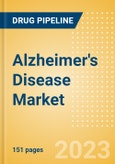Alzheimer's Disease (AD) is a progressive neurodegenerative disease that is characterized by memory loss, cognitive impairment, and functional decline. Mild cognitive impairment (MCI) is a phase of the AD continuum in which a gradually progressive cognitive decline occurs and may even become clinically relevant. According to the pathology of the disease, MCI typically occurs after a long (10 years or more) asymptomatic preclinical phase and precedes AD dementia, therefore connecting asymptomatic preclinical AD to the symptomatic phases.
The current competitive landscape in AD mostly consists of symptomatic treatments, of which acetylcholinesterase inhibitors have been the first line of therapy for AD for nearly two decades. However, the market landscape is set to undergo rapid changes in the next decade, driven by advancing diagnostic capabilities and growing social awareness of the disease. The first disease-modifying therapies (DMTs) have been approved, which will bring about a new era in the treatment of this neurodegenerative condition. As a global push is made for early diagnosis and treatment, there will be a surge in the number of AD patients who require effective therapies.
Key Highlights
Report deliverables include a Word report and Excel-based forecast modelForecasts includes the 8MM
Forecasts covers from 2020-2030
The prevalence of AD is increasing in line with an aging global population in the 8MM.
The current competitive landscape in AD mostly consists of symptomatic treatments, of which the acetylcholinesterases are the most commonly prescribed drug class for managing AD.
The greatest unmet need in the AD market is for curative treatments, followed by wider availability of disease modifying therapies.
The AD pipeline is is diverse with a wide variety of unique mechanisms of action present, highlighting the poorly understood nature of the disease and the many mechanism thought to be involved in disease pathology.
The AD market will exhibit significant growth between 2020 and 2030, driven by the launch of 23 pipeline agents, including several drug candidates that have the potential to modify the underlying cause of the disease.
Scope
- Overview of Alzheimer's disease (AD), including epidemiology, symptoms, diagnosis, and disease management.
- Annualized AD therapeutics market revenue, cost of therapy per patient, and treatment usage patterns in four patient segments (mild cognitive impairment, mild AD, moderate AD, and severe AD) forecast from 2020 to 2030.
- Key topics covered include strategic competitor assessment, market characterization, unmet needs, clinical trial mapping and implications for the AD therapeutics market.
- Pipeline analysis: comprehensive data assessing emerging trends and mechanisms of action under development for AD treatment. The most promising candidates in Phase III development are profiled.
- Analysis of the current and future market competition in the global AD therapeutics market. Insightful review of the key industry drivers, restraints and challenges. Each trend is independently researched to provide qualitative analysis of its implications.
Reasons to Buy
- Develop and design your in-licensing and out-licensing strategies through a review of pipeline products and technologies, and by identifying the companies with the most robust pipeline.
- Develop business strategies by understanding the trends shaping and driving the global AD therapeutics market.
- Drive revenues by understanding the key trends, innovative products and technologies, market segments, and companies likely to impact the global AD therapeutics market in the future.
- Formulate effective sales and marketing strategies by understanding the competitive landscape and by analysing the performance of various competitors.
- Identify emerging players with potentially strong product portfolios and create effective counter-strategies to gain a competitive advantage.
- Organize your sales and marketing efforts by identifying the market categories and segments that present maximum opportunities for consolidations, investments and strategic partnerships.
Table of Contents
Companies Mentioned (Partial List)
A selection of companies mentioned in this report includes, but is not limited to:
- AbbVie
- AB Science
- AgeneBio
- AlphaCognition
- Alzheon
- Anavex Life Sciences
- AriBio
- Athira Pharma
- Axsome Therapeutics
- Biogen
- BioVie
- BioXcel Therapeutics
- Cassava Sciences
- Cerecin
- Changchun Huayang High-Tech
- Corium
- Daiichi Sankyo
- Eisai
- Eli Lilly
- Grifols
- Johnson & Johnson
- Lundbeck
- Luye Pharma
- Mertz Pharma
- Novartis
- Novo Nordisk
- Ono Pharmaceutical
- Otsuka Pharmaceutical
- Shanghai Green Valley Pharmaceutical
- Suven Life Sciences
- Takeda
- TauRx Therapeutics
- Teikoku Seiyaku
- Towa Pharmaceutical








